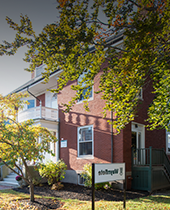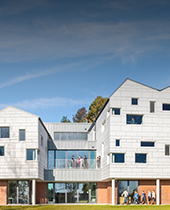6 Ways a Reggio Preschool Can Change the Way Your Child Learns
By Bob Mills, Debbie Rowe, Gretchen Schaefer (EC faculty)
The Reggio Emilia philosophy, which inspires our Early Childhood program, contends that essential skills are best learned when students are genuinely engaged in what they’re learning. 听起来很简单. But what if your school encouraged three- and four-year-olds to literally decide what they will study?
Below are some of the ways a Reggio Emilia program will change your thinking about the traditional classroom, 教学的艺术, and the role your child can play in their own learning.
1. A Different Image of the Child
Reggio begins with the premise that children are competent and active p艺术icipants in their own learning; that they naturally make meaning of the world around them; and that they are keen observers, 充满好奇, who seek to express their understanding in a variety of ways. In a Reggio classroom, learning is a shared enterprise between students and teachers.
2. 紧急课程
It all begins with a unique collaboration between teachers and students. Instead of a traditional classroom in which teachers try to engage children in a series of lessons, the curriculum emerges from careful observations of our students. The teachers’ role is to identify and guide students toward topics that have the potential for sustained interest.
3. Teaching as Collaboration
A Reggio-inspired curriculum is more than “free choice.” Teachers must provide stimulating materials and experiences that promote active learning—through children’s questions, 对话, 故事, 幻想游戏, 艺术, 音乐, 建筑, 实地考察旅行, and other means of expression that Reggio calls “the 100 languages of children.”
4. The 100 Languages: Teaching Children to Think
While many three- and four-year-olds are at the early stages of literacy, Reggio recognizes the many “languages” in which children make meaning of the world and express their understanding of what they’ve learned. 创造故事, 歌曲, 幻想, 艺术, and even outdoor play with a beginning, 一个中间, and an end is more than just fun. It’s a powerful way of learning how to think creatively and sequentially. 以这种方式, the Reggio approach provides a captivating form of learning that encourages children to investigate things themselves, and identify and reveal their interests with the confidence that they will be taken seriously.
5. 环境作为教师
In Reggio programs like ours, careful attention is paid to designing a classroom space that is both aesthetically compelling and supportive of students’ independent and purposeful work. The environment allows for independent, 小组, 以及大型团队工作, as well as areas set aside for designated activities. 在新巴黎人注册网站的教室里, students can draw or paint in the 艺术 studio, write and perform their own 歌曲 in the conservatory, or sit quietly in the mindfulness corner and breathe. 当然, there’s always a place for imaginative play, messy science experiments, or large construction work. All these activities engage students while enlarging their understanding of the world.
6. 文档
文档 is an integral p艺术 of the Reggio Emilia approach. It allows parents and children to follow the progress of the classroom. 更多的 importantly, it shows children how we value them, their thoughts, their words, and their work. At Waynflete we use cameras, video, laptops, and iPads to document our students’ work. Their learning also comes alive in our daily class journal, 歌曲录音, videos of curricular work, and on our classroom webpage.
Reggio-inspired programs share the view that spontaneity is key to deep learning. Reggio programs are informed by the place they inhabit, 教书的老师, and the children who come. The style of instruction, 的材料, 环境, and the curriculum are shaped by each group of students. The approach always begins with the child.




